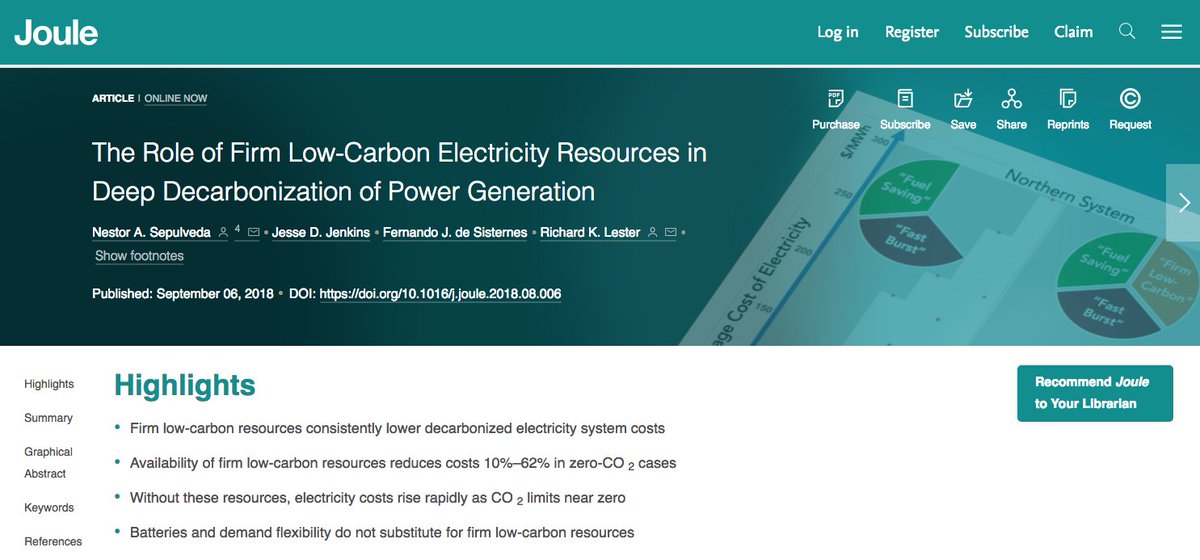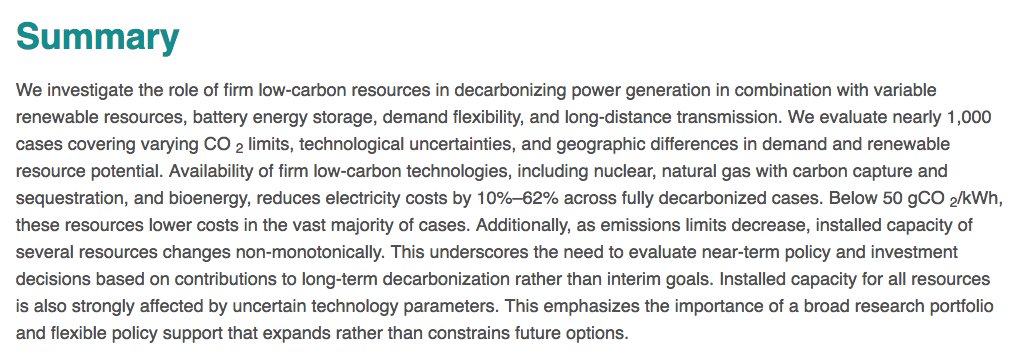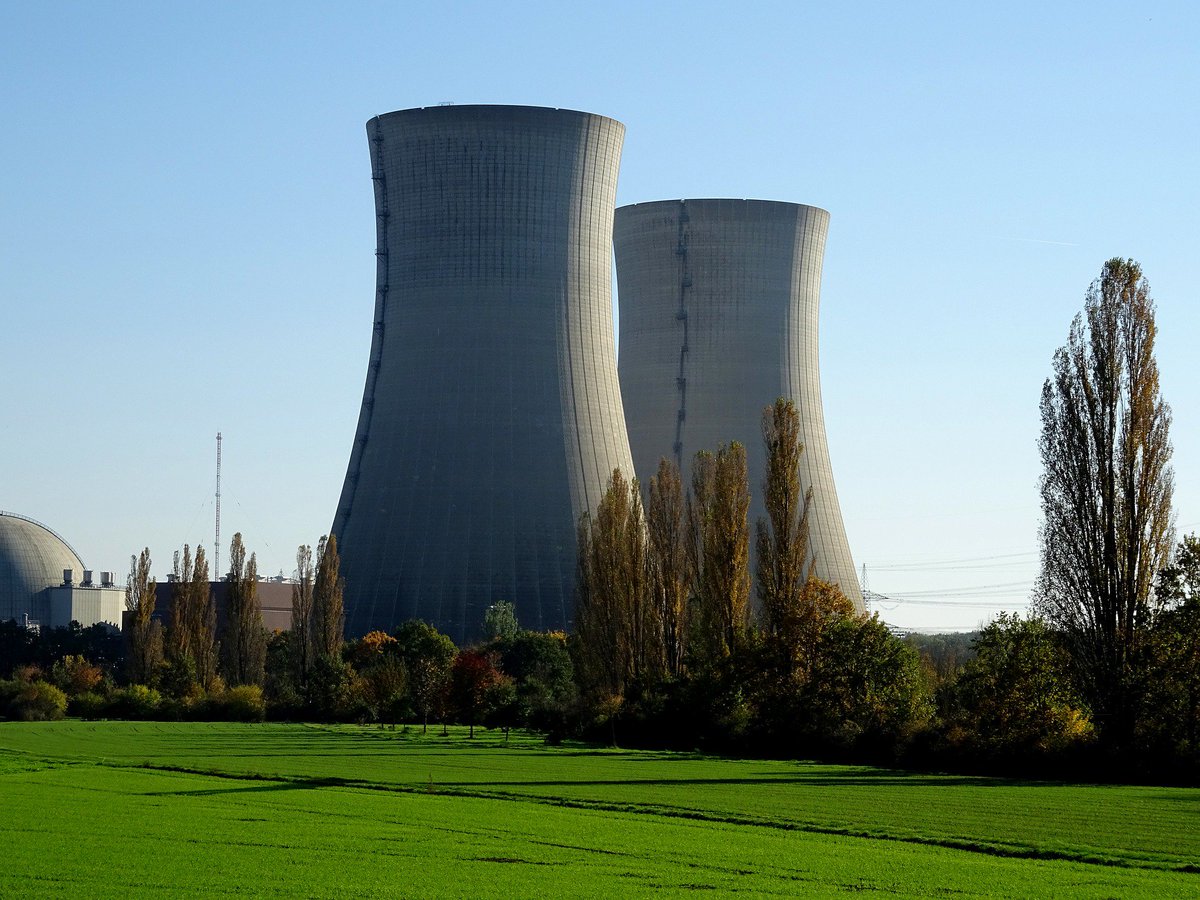I was about to head offline for 2 weeks, but I need to respond to this new paper from @ppchef before I go on whether #nuclear can operate flexibly. By coincidence, I just had a peer-reviewed article on this very subject accepted by Applied Energy by today! So here's a thread...
External Tweet loading...
If nothing shows, it may have been deleted
by @PPchef view original on Twitter
In this new "discussion paper," energy journalist @PPchef takes great pains to demonstrate that nuclear power is too inflexible to pair well with wind & solar in a "decarbonized energy system" & thus must be discarded "to make room" for more #wind & #solar publications.iass-potsdam.de/pubman/item/es…
I'm going to defer technical discussion of whether nuclear plants (old and new) can ramp or change output to match fluctuations in net demand and contribute to system reliability/flexibility until my paper is released (short answer: they certainly can if doing so is valuable)...
Instead, I want to focus this thread on how the entire reasoning behind the argument that nuclear must go to make room for wind + solar is backwards and spurious and has nothing to do with decarbonizing electricity (and everything to do w/manufacturing reasons to shutter nuclear)
This is common refrain of supporters of Germany's Energiewende, including @ppchef, as well as US-based proponents of a "soft energy path" to decarbonization such as RMI's Amory Lovins. So it is worth pausing to unpack the (spurious) logic for a moment.
Let's walk through an example: here is a week of hourly operations of a hypothetical power system with 2/3rds of its energy from low-carbon sources: 1/3 each from nuclear and wind + solar. Start by assuming the nuclear is entirely inflexible and must run at 100% at all times. 
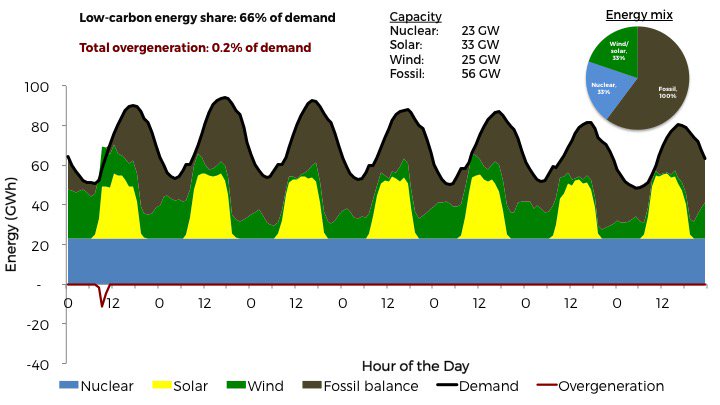
In this case, available wind & solar energy only exceeds demand minus nuclear output in only 2 hours before 12 on the 1st day. This "overgeneration" is enough to supply just 0.2% of the weekly demand. That energy must be either curtailed (wasted), exported or stored for later use 
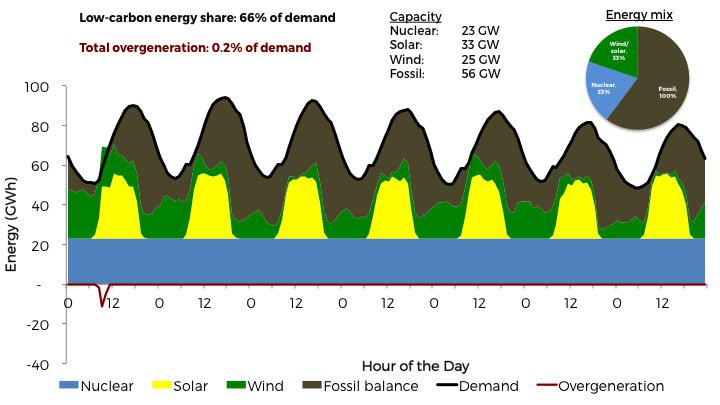
That shouldnt be too much of a problem. So already we have a 66% low-CO2 grid and little conflict between the 33% nuclear and 33% wind and solar. A tiny bit of storage or transmission interconnection with other grids or in the worst case, a little curtailment, and you're all good
What if we want to go to 80% low-CO2? Look at the next example pictured here. We have 33% nuclear + 47% wind/solar. Nuclear is still entirely inflexible and now overgeneration is more common, totaling 2.8% of demand to be stored, exported or curtailed. But no big problems really. 
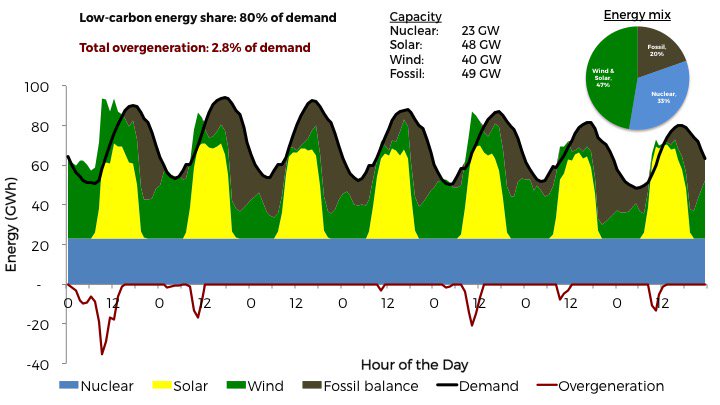
We can do even better though if nuclear is somewhat flexible. Now let's assume nuclear can ramp down to 50% of its maximum output. Much less flexible than a gas plant, but helpful still. Overgeneration is down to a minor 0.7% of demand. Wind+solar up to 49%, nuclear down to 31%. 
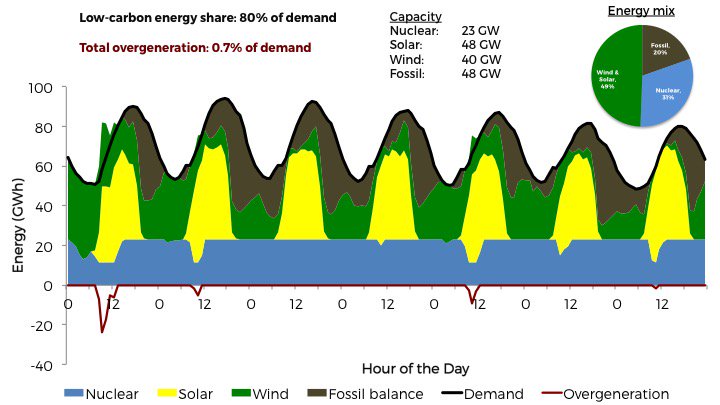
Curtailment of wind/solar falls by ~75%. This flexible nuclear example will thus be lower cost overall, because we can use more of the free energy from wind + sun here without exporting, storing or curtailing it.
In addition, nuclear reactor owners make more money, because they are ramping down output when there is an excess of wind and solar and thus market prices are $0/MWh or even negative. They can then sell their spare capacity as operating reserves/balancing which makes more money.
So a win-win-win outcome with only modest nuclear flexibility: 1) lower wind & solar overgeneration, 2) lower overall system costs, and 3) higher revenues for nuclear operators. (Foreshadowing here for my forthcoming paper's findings!) And we're at an 80% decarbonized grid.
What happens if we head advice of @PPChef & others who counsel that we must get rid of nuclear to make room for more output from wind & solar and avoid having to export, store or curtail excess wind or solar output? Let's take the nuclear out of the above example in this graphic. 
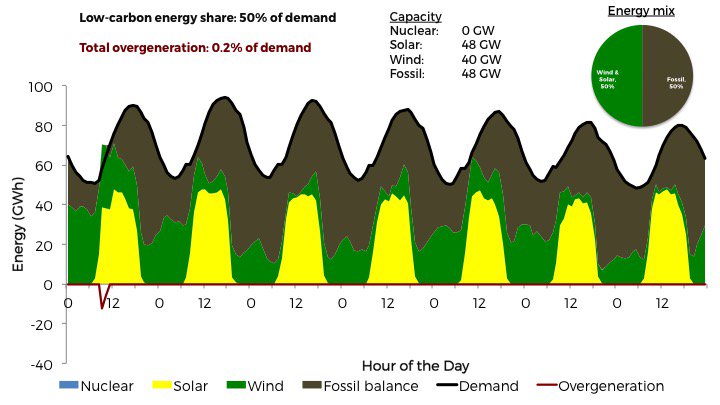
Sure enough, we've reduced overgeneration to 0.2% of weekly demand, vs 2.8% if we have totally inflexible nuclear and 0.7% if we have flexible nuclear. Wind and solar are now up to 50% of total energy, vs 47% and 49% in the inflexible/flexible nuclear examples above.
So score one for wind and solar, just as @PPChef envisions. But what happens to emissions? Now that we've gotten rid of our nuclear units, the fossil energy share (coal, lignite or gas plants) needed to balance the wind and solar rises sharply to 50%, up from only 20% previously.
So we've managed to get an addition 1-3% energy share from wind and solar compared to the cases with nuclear in the mix, but at the cost of a net loss of 30% low-carbon energy share. This mix is only 50% decarbonized, vs 80% if we kept nuclear around.
Sound familiar? Well that's exactly what has happened in Germany as nuclear units have gone offline as part of the Energiewende's misplaced priorities, and it is also what is likely to happen elsewhere if the advice of Energiewenders or soft energy path advocates is headed.
.@PPChef is working hard to find reasons why wind & solar cant get along w/nuclear and create another reason to justify nuclear retirements. But if decarbonizing the power system quickly & affordably is your goal, that argument holds no water, whether nuclear is flexible or not!
If you don't want nuclear in your energy mix, it's fine to just say so and have an open debate about it. If you want to maximize wind & solar at any cost, no matter if it means higher CO2 emissions and more gas, coal or lignite burned, go for it.
But don't claim your arguments for getting rid of nuclear have anything to do with transitioning to "a decarbonized electricity system" as @PPChef's discussion paper is subtitled.
Getting rid of a reliable low-carbon resource that runs nearly 24-7 to make room for more intermittent wind & solar output which must be backed up with fossil generators at all other times is obviously a bad deal from a CO2 perspective, and the examples above clearly show that.
Finally, note it gets even easier to integrate wind & solar with nuclear (flexible or otherwise) if you have all of the energy storage, demand-side flexibility, power to gas and other flexibility measures the Energiewende requires. There's no technical reason to discard nuclear.
I'll be back in a couple weeks to talk more about this. But in the meantime, next time someone tells you nuclear has to go to "make room for wind & solar," ask them what that will mean for total CO2 emissions & fossil energy consumption? You're not going to like the answer. /End
Doh! Error in the energy shares by chart. Fossil share should be 33% not 100% (obviously!)
Here is a corrected graphic for posterity. 
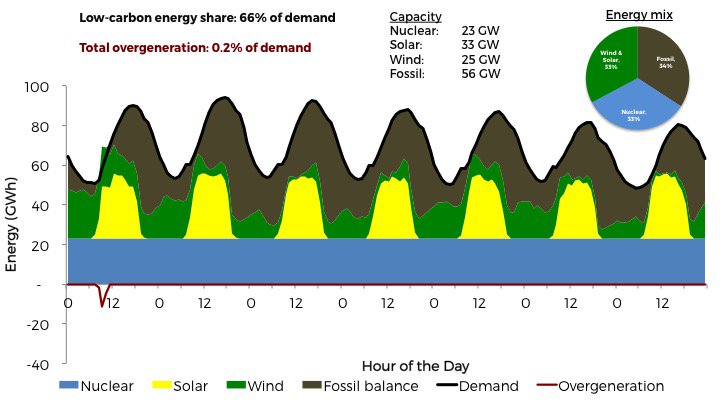
You can download these graphics as a single PDF here (including correction for error in energy shares pie chart in the first figure): bit.ly/NuclearAndRene…
And thanks to the handy dandy @threadreaderapp, here is a webpage with this full thread in more typical blog-style format if you prefer: threadreaderapp.com/thread/9707438…
• • •
Missing some Tweet in this thread? You can try to
force a refresh





